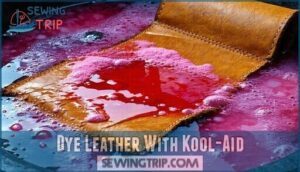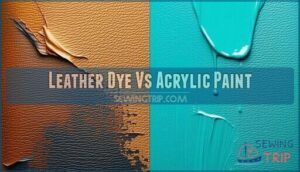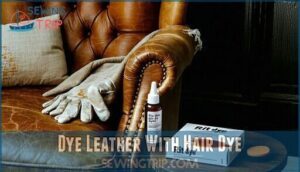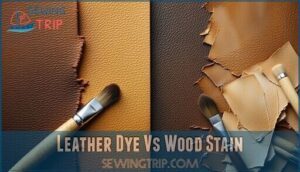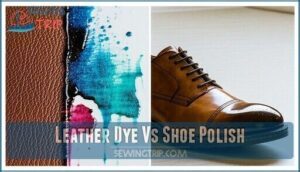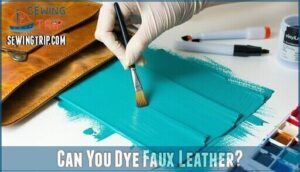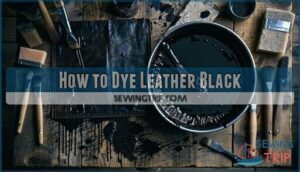This site is supported by our readers. We may earn a commission, at no cost to you, if you purchase through links.
 You can dye leather with several household items beyond traditional leather dyes.
You can dye leather with several household items beyond traditional leather dyes.
Rit fabric dye works well on vegetable-tanned leather, creating rich, vibrant colors when applied properly.
Coffee grounds mixed with hot water make an excellent natural brown stain that penetrates leather beautifully.
Regular acrylic paint sits on the surface rather than penetrating, making it less durable than true dyes.
Hair dye, Kool-Aid, tea, and food coloring all work as alternative leather colorants, though results vary by leather type.
Wood stain can also color leather effectively, while shoe polish provides temporary color that rubs off easily.
The key is understanding which methods actually penetrate versus just coating the surface, and knowing the right preparation techniques can make even unconventional materials work surprisingly well, using items like Rit fabric dye, coffee grounds, hair dye, wood stain, shoe polish, and other household items to achieve the desired color.
Table Of Contents
- Key Takeaways
- Can You Dye Leather?
- Who Can Dye Leather Shoes?
- Do You Dye Leather Before or After Sewing? (Tooling or Burnishing)
- What Do You Dye Leather With?
- Dye Leather With Rit
- Dyeing Leather With Coffee
- Dye Leather With Kool-Aid
- Leather Dye Vs Acrylic Paint
- Dye Leather With Hair Dye
- Leather Dye Vs Wood Stain
- Dye Leather With Tea
- Dyeing Leather With Food Coloring
- Leather Dye Vs Shoe Polish
- Can You Dye Faux Leather?
- How to Dye Leather Shoes
- Dyeing Leather Couch
- How to Dye Leather Black
- Frequently Asked Questions (FAQs)
- Conclusion
Key Takeaways
- You can use Rit dye on leather effectively – Mix it with hot water around 140°F and soak vegetable-tanned leather for 10-30 minutes for vibrant, long-lasting colors that penetrate deep into the fibers.
- Coffee creates natural brown leather stains – Brew extremely strong coffee, optionally add steel wool for darker tones, then soak leather for 30 minutes to 8+ hours, depending on your desired shade intensity.
- Surface coatings like paint work differently than penetrating dyes – Acrylic paint sits on top and works on any leather type, including faux leather, while true dyes, like Rit, absorb into the material for permanent color changes.
- Proper preparation determines your success – Clean leather thoroughly, remove existing finishes through light sanding, test on hidden areas first, and always condition afterward to prevent cracking and maintain flexibility.
Can You Dye Leather?
Yes, you can dye leather with proper preparation and the right materials. Leather dyeing opens up a world of creative possibilities, transforming worn-out boots into statement pieces or giving new life to that vintage jacket gathering dust.
The key lies in understanding that leather type matters substantially. Vegetable-tanned leather accepts dye beautifully, while chrome-tanned varieties need extra prep work.
Success depends on matching your dye method to your leather type—no shortcuts here.
Your dyeing preparation steps should include thorough cleaning and light sanding to remove existing finishes. This is crucial for achieving the desired color consistency** and ensuring the dye adheres properly.
Leather dye options range from traditional alcohol-based dyes to household items like rit dye and coffee dye for natural leather staining effects. Each method offers different results – commercial leather dye provides vibrant, consistent colors, while coffee dye creates rustic, aged appearances.
Achieving color consistency requires patience and testing on scraps first. Don’t rush the process; multiple thin coats beat one heavy application every time.
Who Can Dye Leather Shoes?
While anyone can attempt DIY shoe dyeing, success depends on several key factors that’ll make or break your project:
- Skill Level Needed – Basic leather knowledge helps avoid costly mistakes
- Cost Considerations – Professional leather services often cost less than ruined shoes
- Age Restrictions – Adult supervision required for chemical dyes like Rit dye
- Time Investment – Coffee stain methods take hours, not minutes
You can dye leather shoes yourself, but leather dye penetrates differently than expected. Faux leather resists most treatments, while vegetable-tanned leather yields unpredictable results.
Expect the unexpected – leather dyeing rarely goes according to plan, but that’s half the fun.
To dye suede shoes successfully, choose the right dye for the material.
Do You Dye Leather Before or After Sewing? (Tooling or Burnishing)
Why rush into stitching when proper Dyeing Sequence can make or break your project? You’ll want to dye leather before any sewing, tooling, or burnishing begins.
Here’s the smart Assembly Order:
| Step | Action | Reason |
|---|---|---|
| 1 | Clean & dye leather | Guarantees even penetration |
| 2 | Tool & burnish | Protects dyed surface |
| 3 | Cut & sew | Maintains color integrity |
Stitching Considerations matter because needles can create uneven spots if you paint stain afterward. Tooling Impact becomes problematic when leather dye can’t penetrate properly around pressed designs. Burnishing Effects also seal the surface, blocking rit dye absorption.
Think of it like painting a house – you wouldn’t paint the walls after installing trim. Smart dyeing techniques involve treating raw leather first, then adding your artistic touches. This approach prevents color bleeding, guarantees consistent coverage, and gives you better control over the final appearance of your handcrafted piece.
What Do You Dye Leather With?
In the process of transforming your leather goods, you’ve got several reliable options beyond traditional leather dye.
Understanding dyeing preparation and safety guarantees your project succeeds from start to finish. The right materials make all the difference in achieving professional results.
Your dyeing alternatives depend on the leather type and desired outcome:
- Rit dye – penetrates deeply for vibrant, long-lasting colors on most leather types
- Coffee dye – creates natural brown tones with an aged, vintage appearance
- Acrylic paint – bonds well to faux leather surfaces for consistent coverage
- Food coloring – offers unique color variations on untreated leather projects
- Tea staining – produces subtle antique effects using natural tannins
Proper dyeing application requires clean, conditioned leather for even absorption. Focus on dyeing durability by sealing your finished piece to prevent color transfer and extend the life of your custom work.
Dye Leather With Rit
Rit dye works on leather, but here’s what you need to know before diving in. While Rit’s designed for fabric, it can give your leather projects a fresh look when you prep properly.
Start with vegetable-tanned or unfinished leather for best results. Smooth, heavily finished leather won’t absorb Rit dye well, leaving you with patchy coverage. Clean your leather thoroughly and consider deglazing glossy surfaces so the dye penetrates evenly.
The dyeing process steps are straightforward: heat water to about 140°F, dissolve your chosen Rit Dye Colors, then submerge the leather for 10-30 minutes. Keep stirring for even color distribution. Longer soaking doesn’t always mean darker results – test scraps first.
Here’s the catch: Rit won’t give you the vibrant, long-lasting color that specialized leather dyes deliver. The salt content can dry out leather fibers, so conditioning afterward is non-negotiable. Sealing after dyeing helps lock in color, but expect some fading over time. For a bolder look, consider acrylic leather dyes.
For serious leather projects requiring durability considerations, stick with alcohol-based leather dyes. Rit works for experimental pieces where you’re after that soft, vintage aesthetic.
Dyeing Leather With Coffee
Looking beyond traditional leather dyes, coffee offers a natural DIY leather dye alternative that’s both eco-friendly and surprisingly effective.
This coffee dye recipe works best on vegetable-tanned leather, creating rich brown tones that range from light camel to deep chocolate.
Coffee Dye Recipe essentials:
- Brew extremely strong coffee using dark roast beans or instant coffee
- Add a piece of steel wool to darken the color intensity
- Soak leather fully submerged for 30 minutes to 8+ hours
- Rinse thoroughly with cold water after dyeing
- Apply leather conditioner immediately to prevent brittleness
Leather Type Matters – vegetable-tanned leather absorbs coffee staining far better than chrome-tanned varieties.
Color Intensity Control comes from brew strength and soaking time.
Adding iron to the coffee brew can also darken the dye.
Drying Considerations are essential since coffee’s sugars can make leather stiff without proper conditioning.
Mold Prevention requires complete air-drying before storage.
While coffee dye won’t match commercial leather dye vibrancy, it creates beautiful natural patinas perfect for rustic projects.
Dye Leather With Kool-Aid
While coffee gives leather a rustic look, you can dye leather with Kool-Aid for colorful results.
This unconventional dyeing technique uses acid dyes that bond with leather’s protein fibers when mixed with vinegar.
However, Kool-Aid colors fade faster than traditional leather dye options.
| Aspect | Details |
|---|---|
| Kool-Aid Colors | Limited palette; Red 40 works best |
| Leather Compatibility | Works on vegetable-tanned leather |
| Fading Resistance | Poor; colors wash out over time |
| Application Techniques | Hot water bath with vinegar added |
The process involves dissolving unsweetened Kool-Aid powder in hot water, adding vinegar for acidity, then soaking your leather piece.
While sealing considerations include applying protective finishes afterward, this method works better for experimental leather crafting projects than professional work.
Expect lighter colors than advertised and potential bleeding when wet.
Leather Dye Vs Acrylic Paint
When you’re debating between leather dye and acrylic paint for your next project, understanding their differences can save you time and money.
Both leather colorants offer unique advantages, but they work differently on various leather types.
Leather dye penetrates deep into the fibers, creating a natural finish that maintains the material’s texture and flexibility.
It’s perfect for full-grain leather but won’t work on sealed or coated surfaces.
Acrylic paint, however, sits on top and works on almost any leather type, including faux leather.
| Feature | Leather Dye | Acrylic Paint |
|---|---|---|
| Penetration | Deep fiber absorption | Surface coating |
| Durability | Long-lasting, won’t crack | May crack without sealing |
| Color Options | Limited palette | Unlimited mixing potential |
For durability comparison, dye wins on longevity while paint excels in color vibrancy.
Application techniques differ too – dye requires absorbent leather while paint needs proper surface prep.
Cost analysis shows paint’s typically cheaper upfront, making it budget-friendly for leather customization projects.
To confirm your project lasts, consider factors affecting leather paint’s resistance.
Dye Leather With Hair Dye
You’re venturing into uncharted territory when you dye leather with hair dye.
While tempting due to its vibrant colors, hair dye chemicals like PPD aren’t formulated for leather’s unique structure. This mismatch creates serious concerns:
- Unpredictable results – Blotchy, uneven coverage that screams amateur hour
- Chemical damage – Your beloved leather could crack, dry out, or become brittle
- Color permanence issues – Expect fading, bleeding, and transfer onto clothes
Hair dye application techniques don’t translate well to leather dyeing. The sealing considerations become complex since traditional leather finishes may not bond properly with hair dye residue.
You’ll likely need multiple coats and extensive conditioning afterward. Instead of gambling with hair dye, stick with proven leather dye or rit dye – your leather will thank you.
Leather Dye Vs Wood Stain
Understanding the difference between leather dye and wood stain can save you from disappointing results.
While both products add color, they work differently on leather surfaces. Leather dye offers superior pore penetration and color fastness, while wood stain sits primarily on the surface.
Here’s what you need to know:
| Feature | Leather Dye | Wood Stain |
|---|---|---|
| Material Compatibility | Designed for leather fibers | Formulated for wood surfaces |
| Application Differences | Deep penetration, uniform color | Surface coating, may appear blotchy |
| Finish Durability | Permanent but may fade | Can peel or wear off leather |
When staining leather, choose products made specifically for it. Rit dye works better than wood stain for leather finishing projects.
Dye Leather With Tea
Tea staining offers you a gentle, natural approach to leather dyeing that’s been around for centuries. Unlike wood stain’s harsh chemicals, tea uses tannins that naturally bond with leather fibers.
You’ll find black tea produces the richest browns, while green tea creates lighter, more subtle tones.
Here’s your tea staining roadmap:
- Steeping Time matters – Brew strong tea for 30+ minutes using multiple tea bags for deeper color concentration
- Tea Types deliver different results – Black tea gives warm browns, while herbal teas like rooibos create unique amber tones
- Color Fastness requires sealing – Apply leather conditioner after dyeing to lock in your tea stain and prevent fading
The tannin levels in different teas directly affect your final shade.
You’ll get better sealing effects by conditioning immediately after the leather dries completely.
Dyeing Leather With Food Coloring
Food coloring offers surprising color vibrancy for leather dye alternatives. This budget-friendly method works best on untreated, absorbent leather with proper leather preparation.
Here’s your step-by-step approach:
- Clean thoroughly – Remove oils and finishes so the food coloring penetrates evenly
- Mix strategically – Combine 12 drops with one cup vinegar for enhanced brightness and setting
- Apply your way – Choose from painting, dipping, or spraying application methods
- Seal properly – Use protective topcoat for improved dye longevity and color retention
While dyeing techniques using food coloring won’t match professional leather dye durability, they’re perfect for creative projects. The vinegar acts as a mordant, intensifying colors and helping them stick. Your leather might stiffen slightly, but gentle manipulation restores flexibility after the 24-hour drying period.
Leather Dye Vs Shoe Polish
Beyond food coloring’s vibrant possibilities, you’re probably wondering how leather dye stacks up against shoe polish.
Here’s the straight talk: they’re completely different animals with distinct purposes.
Leather dye penetrates deep into leather fibers, creating permanent color transformation through superior dye penetration.
Shoe polish sits on the surface, offering temporary shine and minor color enhancement through polish pigment layers.
| Feature | Leather Dye | Shoe Polish |
|---|---|---|
| Color Durability | Permanent, fade-resistant | Temporary, wears off |
| Application Method | Absorbs into fibers | Surface coating only |
| Leather Protection | Requires separate conditioner | Contains protective waxes |
| Color Range | Wide spectrum available | Limited traditional shades |
| Coverage | Even, deep penetration | Surface-level touch-ups |
Think of leather dyeing as surgery—it’s permanent and transformative.
Shoe polish is more like makeup—it enhances what’s already there but washes away eventually.
Can You Dye Faux Leather?
Somebody’s probably told you that faux leather can’t be dyed like real leather – and they’re mostly right.
Traditional leather dye vs paint becomes essential here since faux leather’s synthetic surface won’t absorb standard dyes. However, you’ve got several workarounds that’ll transform your synthetic pieces.
Here’s your faux leather dyeing toolkit:
- Acrylic paint – Apply thin, even coats after proper faux leather prep for lasting color
- Vinyl wraps – Stick decorative films over the surface for instant, removable makeovers
- Fabric markers – Perfect for small touch-ups and detailed work on accessories
- Specialized leather paint – Bonds better than regular acrylics and works on both real and synthetic materials
The secret lies in surface preparation and sealing faux leather afterward. While you can’t use Rit dye like you’d on genuine leather, these alternatives deliver impressive results.
Remember, patience beats rushing – multiple thin applications always trump one thick coat that’ll crack later.
How to Dye Leather Shoes
Your favorite sneakers don’t have to stay stuck in boring beige forever. Transforming leather shoes with dye opens up a world of creative possibilities, whether you’re matching an outfit or breathing new life into worn footwear.
Start with proper Shoe Dye Prep by cleaning thoroughly and removing any existing finish. Color Matching Shoes requires testing your chosen leather dye on a hidden area first – you’ll avoid nasty surprises this way. For Dye Application Tips, work in thin, even coats using circular motions, allowing each layer to dry completely.
Here’s what makes shoe dyeing truly rewarding:
- The satisfaction of creating unique footwear that nobody else owns
- Saving money by revitalizing old favorites instead of buying new pairs
- Expressing your personal style through custom colors and effects
Sealing Dyed Shoes with appropriate finisher protects your work and guarantees Shoe Dye Durability. These dyeing techniques transform ordinary leather shoes into personalized statement pieces that reflect your creativity.
Dyeing Leather Couch
Transformation awaits your tired leather couch with the right approach. Start by thoroughly cleaning the surface to remove dirt, oils, and existing conditioners that’ll block dye absorption. Test your chosen dye in a hidden spot first—Color Matching Couches requires understanding how your leather’s original shade affects the final result. Different leather types respond differently, making Couch Material Impact vital for success.
Essential considerations for Dyeing Large Couches:
- Workspace preparation: Cover floors and nearby furniture—leather dye stains everything it touches
- Even application: Work in sections using consistent pressure and overlapping strokes to avoid streaks
- Couch Dye Durability: Apply thin, multiple coats rather than one thick layer for better penetration
Choose from rit dye for budget-friendly results, specialized leather dye for professional finish, or leather paint for complete color changes. Each dyeing technique requires patience—rush the process and you’ll get blotchy results. Focus on Protecting Dyed Couch afterward with proper conditioning to maintain flexibility and prevent cracking.
How to Dye Leather Black
You can achieve a deep, rich black color on leather using several effective methods that go beyond traditional leather dyes.
Whether you’re working with Rit dye for a budget-friendly approach or experimenting with natural options like vinegar and tea, the key is proper preparation and patience for professional-looking results.
Using Rit Dark Brown All Purpose Liquid Dye
The right Rit dye can breathe new life into worn leather pieces. Rit Dark Brown All Purpose Liquid Dye offers an accessible leather dye tutorial for beginners, though proper leather prep needed includes thorough cleaning and light sanding.
The dyeing process steps involve mixing dye with hot water, then submerging leather for 10-30 minutes.
| Step | Time Required | Key Considerations |
|---|---|---|
| Prep leather | 15-30 minutes | Clean, sand lightly |
| Mix dye solution | 5 minutes | Hot water, proper ratio |
| Dye application | 10-30 minutes | Monitor color development |
| Dry and condition | 24+ hours | Air dry completely |
However, colorfastness concerns arise since Rit dye wasn’t designed for leather dyeing. Rit Dye results often appear less vibrant than specialized leather dyes.
Sealing recommendations include applying leather finish afterward to prevent color transfer and extend durability.
Using a Mixture of Vinegar and Black Tea Soak
While Rit dye works great for bold colors, you can achieve rich black tones using a vinegaroon alternative with black tea and vinegar.
This natural leather dye method harnesses tea tannins for deep color modification without harsh chemicals.
Brew strong black tea using six bags per cup of hot water. Let it cool completely, then add two tablespoons of white or apple cider vinegar per cup.
The acid helps tea tannins penetrate leather fibers more effectively.
Clean your leather first, then submerge it in the tea mixture for 8-24 hours. Longer soaking creates darker results, though it may increase leather hardness.
Check progress every few hours.
After soaking, rinse with cold water and air dry completely.
The leather dye tutorial isn’t complete without proper conditioning – apply leather oil to restore flexibility. This tea staining technique delivers vintage appeal through proven leather dyeing techniques.
Frequently Asked Questions (FAQs)
Does Rit dye stain leather?
Yes, you can stain leather with Rit dye, though it’s less vibrant than leather-specific dyes.
It works best on unfinished, lighter leather and requires proper cleaning first.
Results vary by leather type.
What household items can I use to dye leather?
You’ve got several options sitting in your kitchen right now.
Strong coffee creates nice brown tones, while tea gives lighter shades.
Food coloring works on untreated leather for vibrant colors.
Always test first!
Does coffee stain real leather?
Coffee absolutely stains real leather, creating rich brown tones that range from light tan to deep chocolate.
You’ll need highly concentrated coffee and patience—soaking times vary from thirty minutes to eight hours depending on your desired darkness.
Can you dye leather with paint?
You can dye leather with paint, but it’s more like coating than true dyeing.
Acrylic leather paints work best, sitting on the surface rather than penetrating fibers like traditional dyes do, which is a key point to consider when looking to dye leather.
How long does dyed leather last outdoors?
Dyed leather typically lasts 1-3 years outdoors before fading substantially.
UV rays, rain, and temperature swings break down the color faster than you’d expect, especially with DIY methods like coffee or Rit dye.
Can you dye leather furniture cushions safely?
Like transforming a plain canvas into art, you can safely dye leather furniture cushions with proper preparation and the right products.
Test first, clean thoroughly, use leather-specific dyes, and condition afterward for lasting results.
What temperature water works best for dyeing?
For leather dyeing, you’ll want hot water around 140°F – think steaming coffee temperature.
This heat opens leather pores, letting dye penetrate deeply for rich, even color that won’t fade quickly.
Does leather shrink when dyed with liquids?
When leather meets moisture, it’s like a sponge meeting water—some tightening’s inevitable.
Hot dye baths cause more shrinkage than room temperature applications.
Pre-wet your leather and expect minimal shrinkage with proper technique.
Can you dye over existing leather colors?
You can absolutely dye over existing leather colors, but darker shades work best.
Lighter dyes won’t show over dark leather, so you’ll need stronger colors or bleach first for dramatic changes.
Conclusion
Discovering what can you dye leather with Rit coffee paint stain opens up a world of creative possibilities beyond expensive commercial products.
You’ve learned that household items like Rit dye, coffee grounds, and even Kool-Aid can transform your leather pieces effectively.
Remember that penetrating dyes work better than surface coatings for lasting results.
Whether you’re revitalizing old boots or creating custom projects, these accessible alternatives prove you don’t need specialty stores to achieve beautiful, professional-looking leather finishes at home.





